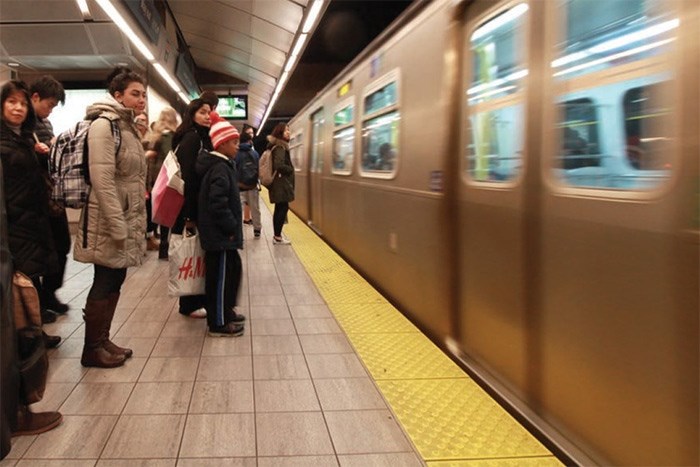 TransLink plans to add 80 new cars to the SkyTrain system between 2018 and 2019 | Rob Kruyt
TransLink plans to add 80 new cars to the SkyTrain system between 2018 and 2019 | Rob Kruyt
What will TransLink look like in the coming decade? For an accurate picture, people need to imagine something not unlike Uber, with mobile technology platforms, on-demand microtransit and extensive bike-share/car-share networks all working together, the companyâs CEO said.
In addition, TransLink may also focus more on helping local companies with employeesâ commutes, through Compass Card programs specifically aimed at businesses and vanpooling programs for locations outside of scheduled transit service networks, in an effort to support the regional economy, said CEO Kevin Desmond.
The transit executive, who made the comments at a Greater Â鶹´«Ã½Ó³»Board of Trade meeting last week, also touted a number of new items to boost capacity in the near future, including new SeaBuses, double-decker buses and 80 new SkyTrain cars between 2018 and 2019.
But with the region expected to add 1.2 million new residents over the next 30 years, he said the focus should be on taking advantage of mobile technology and the data collected on commuter patterns to create a co-operative system with all transportation methods in Metro Â鶹´«Ã½Ó³»working together to stop people from driving alone.
âAdding additional routes and services is fine,â Desmond said. âThatâs what we do as a transit agency ⦠but we need to think about doing something else. Putting a bus route out is not going to work in all places; SkyTrain canât be developed everywhere within a certain amount of time frame. We need to think about alternative ways, and TransLink can help leverage this.â
A key part, Desmond noted, will be the Compass Card program. By last August, the card-tap system â which launched almost two years ago after a number of delays â had logged one billion taps by passengers using the system. All the data collected on travel patterns will play a major role in how TransLink will deploy resources. Other efficiencies â like the ability to pay for transit directly using contactless bank cards or Apple Pay â will also be looked at next year.
âWeâre experiencing â unlike virtually every metropolitan region in all of North America â a surge in ridership,â Desmond said, attributing the growth to a strong local economy and new services like SkyTrainâs Evergreen Line extension. âAs successful as weâve been so far in generating that ridership and helping to support demand, the system is crowded, and itâs going to remain crowded. Improving service attracts more riders, and as we attract more riders, we have to figure out ways to continue to grow the system.â
Statistics show the degree of growth â and the relative increase in demand â of Metro Vancouverâs public transit system. Ridership rose 4.5% in 2016, and numbers through September this year shows a 6.2% increase. Currently, commuters make more than 150,000 journeys through the Commercial-Broadway station each day.
TransLink is working within its mandate of taking directions from the Mayorsâ Council on Regional Transportation and its 10-year plan, which includes the much-discussed six-kilometre, six-station Millennium Line extension on West Broadway, slated for completion in 2025. A light-rail system in Surrey could also receive procurement next year, Desmond noted, with a 10.5-kilometre âL-Lineâ connecting Guildford Exchange to Newton slated for operation in 2024. An extension to Langley is also planned.
But Desmond added that TransLink needs to use private-sector funding wherever it is appropriate to expand the transit market while answering to community demands. He pointed to an example in Richmond, where TransLink is working with the municipal government and a developer on building a new Canada Line station, financed entirely through private means, in the Capstan neighbourhood.
The goal, by encouraging denser developments near transit stations, is to help address the problem of housing affordability by shortening the distance people have to travel to get to work. Desmond said he would like to see the distance of travel for an average Metro Â鶹´«Ã½Ó³»commuter decline by one-third within the next 30 years.
âThis [the Capstan station project] is indicative â by using those private-sector dollars â of how you can generate demand and create a more livable region,â he said. âWhat we are trying to do at TransLink ⦠is preserving, if not improving, the quality of life in this regionâ¦. Connecting jobs and housing is such a big issue; thereâs such a huge intersection between transit and housing. We are aware of that, and we are on it.â
Desmond also floated the idea that TransLink may start providing vans to businesses where a significant number of employees live outside of the transit grid, creating a business-centric vanpooling service based on demand. He said businesses that are interested should contact TransLink directly.
TransLink will continue to maintain the efficiency on systems such as Expo Lineâs 31-year-old tracks in addition to service and capacity expansions â though disruptions on that line occur only rarely despite its age, he added.
As for the future, TransLink plans to begin public consultation on its long-term road map next year, and Desmond said it is important that everyone â businesses or otherwise â share their opinions with the agency.
âWhat I envision for that plan is, itâs time to think big. People tell me all the time, âWhen are you going to the North Shore with SkyTrain? How do we get Canada Line down to Delta?â Thereâs huge pent-up demand to talk about what are the next big thing we should be doing.⦠I hope everyone gets involved in that, because we need a very, very broad public-participation process.â


